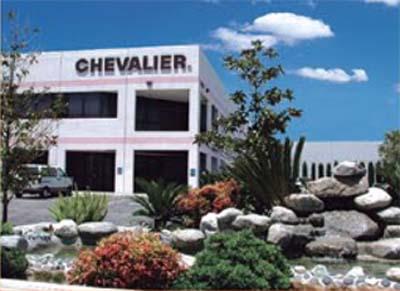
The FVM-3016 from Chevalier Machinery Inc. is a DCL Type Double Column Vertical Machining Center offered, and it features heavy duty precision and state-of-the-art spindles that will make any job easier to complete. And the new QP Vertical Machining Centers will lead the way in their Milling lineup. The FVM-DCL series is our entry level double columns bridge machine.
It provides Large Capacity: table size starts from 126" x 57", Reportedly Great Cutting Capability: 2-speed gearbox spindle that generates maximum 451 ft-lbs torque. Most attractive part is very competitive price. And the new QP series Machining Centers is the C type machining center with heavy duty boxways construction plus 50 taper gear spindle. It is for cutting tough material and the machining capacity is up to 88" x 40".
The Big Bore FBL-500 Series Lathes and FVL-1600VTC Vertical Turning Center are our strongest sellers in their Turning line-up. These high precision, multi-tasking vertical machining centers features a very rigid machine structure which reduces the cutting induced vibration associated with machining hard metals like titanium. And they have fully supported, wide box ways on the Y axis for handling heavy loads. And on the turning side, to satisfy the booming of Energy industry, Chevalier produces the new FBL-500 series horizontal lathe and FVL series Vertical Lathe.
The FBL-500 lathe has a large spindle bore, diameter is up to 12.5" and turning length is 160". The FVL series Vertical Lathe can fit in maximum 98" diameter part with weight up to 26,400 lbs. To eliminate time consume of setup, both models all provide live tooling, C axis, and even Y axis machining capability. The FSG-40/50/60 Series large double column with fixed beam CNC Graphic Conversational Surface Grinders are designed for shops demanding speed, rigidity and a very large grinding area. This series of grinding machines is for grinding large workpieces and are what the biggest machine shops will be looking for.
Contact Details
Related Glossary Terms
- centers
centers
Cone-shaped pins that support a workpiece by one or two ends during machining. The centers fit into holes drilled in the workpiece ends. Centers that turn with the workpiece are called “live” centers; those that do not are called “dead” centers.
- computer numerical control ( CNC)
computer numerical control ( CNC)
Microprocessor-based controller dedicated to a machine tool that permits the creation or modification of parts. Programmed numerical control activates the machine’s servos and spindle drives and controls the various machining operations. See DNC, direct numerical control; NC, numerical control.
- gang cutting ( milling)
gang cutting ( milling)
Machining with several cutters mounted on a single arbor, generally for simultaneous cutting.
- grinding
grinding
Machining operation in which material is removed from the workpiece by a powered abrasive wheel, stone, belt, paste, sheet, compound, slurry, etc. Takes various forms: surface grinding (creates flat and/or squared surfaces); cylindrical grinding (for external cylindrical and tapered shapes, fillets, undercuts, etc.); centerless grinding; chamfering; thread and form grinding; tool and cutter grinding; offhand grinding; lapping and polishing (grinding with extremely fine grits to create ultrasmooth surfaces); honing; and disc grinding.
- lathe
lathe
Turning machine capable of sawing, milling, grinding, gear-cutting, drilling, reaming, boring, threading, facing, chamfering, grooving, knurling, spinning, parting, necking, taper-cutting, and cam- and eccentric-cutting, as well as step- and straight-turning. Comes in a variety of forms, ranging from manual to semiautomatic to fully automatic, with major types being engine lathes, turning and contouring lathes, turret lathes and numerical-control lathes. The engine lathe consists of a headstock and spindle, tailstock, bed, carriage (complete with apron) and cross slides. Features include gear- (speed) and feed-selector levers, toolpost, compound rest, lead screw and reversing lead screw, threading dial and rapid-traverse lever. Special lathe types include through-the-spindle, camshaft and crankshaft, brake drum and rotor, spinning and gun-barrel machines. Toolroom and bench lathes are used for precision work; the former for tool-and-die work and similar tasks, the latter for small workpieces (instruments, watches), normally without a power feed. Models are typically designated according to their “swing,” or the largest-diameter workpiece that can be rotated; bed length, or the distance between centers; and horsepower generated. See turning machine.
- machining center
machining center
CNC machine tool capable of drilling, reaming, tapping, milling and boring. Normally comes with an automatic toolchanger. See automatic toolchanger.
- milling
milling
Machining operation in which metal or other material is removed by applying power to a rotating cutter. In vertical milling, the cutting tool is mounted vertically on the spindle. In horizontal milling, the cutting tool is mounted horizontally, either directly on the spindle or on an arbor. Horizontal milling is further broken down into conventional milling, where the cutter rotates opposite the direction of feed, or “up” into the workpiece; and climb milling, where the cutter rotates in the direction of feed, or “down” into the workpiece. Milling operations include plane or surface milling, endmilling, facemilling, angle milling, form milling and profiling.
- turning
turning
Workpiece is held in a chuck, mounted on a face plate or secured between centers and rotated while a cutting tool, normally a single-point tool, is fed into it along its periphery or across its end or face. Takes the form of straight turning (cutting along the periphery of the workpiece); taper turning (creating a taper); step turning (turning different-size diameters on the same work); chamfering (beveling an edge or shoulder); facing (cutting on an end); turning threads (usually external but can be internal); roughing (high-volume metal removal); and finishing (final light cuts). Performed on lathes, turning centers, chucking machines, automatic screw machines and similar machines.

